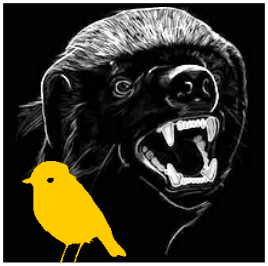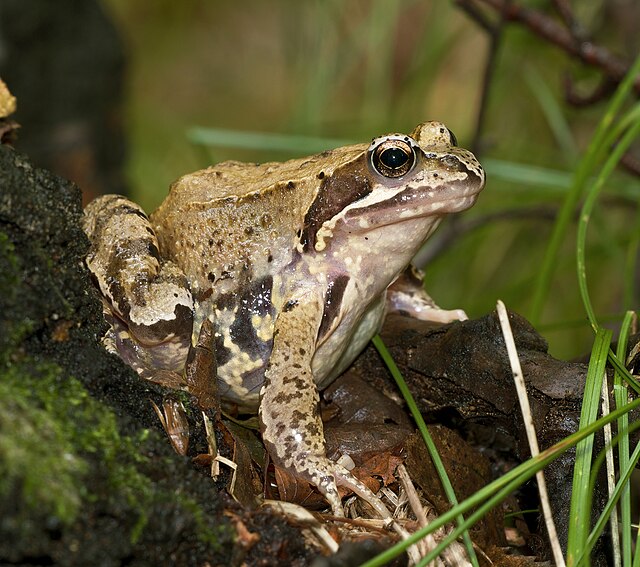Common frog (Rana temporaria) © Jörg Hempel, via Wikimedia Commons
A mutilator of more than just bamboos.
 Prof. Mumblebard claims: “Any species of mammal, bird, reptile or amphibian that eats mainly ants and termites deserves to be called myrmecophagous – a technical term reserved for animals specialising on such a diet. This is because only highly specialised animals are able to find, process, and profit from well-protected, well-defended, unpalatable, indigestible, and energetically poor eusocial insects like ants and termites. Whatever the class of vertebrates involved, myrmecophagy demands specialised adaptations such as small, weak jaws and narrow, darting tongues. This evolutionary principle applies even to frogs, in which ant- and termite-eating species have dumpy bodies and tapering mouths from which tongues can be hydrostatically propelled at various angles. The result is that in many parts of the world, the available eusocial insects are shared among appropriately specialised mammals, birds, reptiles and amphibians while being avoided by other members of all these classes.” … See the hidden half of Prof. Mumblebard’s claim by subscribing here
Prof. Mumblebard claims: “Any species of mammal, bird, reptile or amphibian that eats mainly ants and termites deserves to be called myrmecophagous – a technical term reserved for animals specialising on such a diet. This is because only highly specialised animals are able to find, process, and profit from well-protected, well-defended, unpalatable, indigestible, and energetically poor eusocial insects like ants and termites. Whatever the class of vertebrates involved, myrmecophagy demands specialised adaptations such as small, weak jaws and narrow, darting tongues. This evolutionary principle applies even to frogs, in which ant- and termite-eating species have dumpy bodies and tapering mouths from which tongues can be hydrostatically propelled at various angles. The result is that in many parts of the world, the available eusocial insects are shared among appropriately specialised mammals, birds, reptiles and amphibians while being avoided by other members of all these classes.” … See the hidden half of Prof. Mumblebard’s claim by subscribing here
 Robin and the Honey Badger respond: “Amphibians metabolise so slowly that it’s easy for them to grow on an energy-poor diet of adult ants and termites, whereas birds metabolise so rapidly that it’s difficult for them to do the same. Myrmecophagy therefore needs to be defined according to the different metabolic rates of each class of terrestrial vertebrates. In particular, the criteria of morphological specialisation seen in myrmecophagous mammals and reptiles are too strict for an amphibian such as the termite frog and too lax for a bird such as an antthrush. Relevant points are as follows.
Robin and the Honey Badger respond: “Amphibians metabolise so slowly that it’s easy for them to grow on an energy-poor diet of adult ants and termites, whereas birds metabolise so rapidly that it’s difficult for them to do the same. Myrmecophagy therefore needs to be defined according to the different metabolic rates of each class of terrestrial vertebrates. In particular, the criteria of morphological specialisation seen in myrmecophagous mammals and reptiles are too strict for an amphibian such as the termite frog and too lax for a bird such as an antthrush. Relevant points are as follows.
- Frogs metabolise slowly but can remain fecund on a diet of adult colonial insects, explaining why even frog species with broad mouths accept ants as they encounter them, whereas birds generally avoid ants despite having narrow mouths.
- Terrestrial frogs tend to accept adult ants regardless of whether they forage by sitting-in-wait or active searching.
- The small size of ants makes these insects suitable as food for the juveniles of many species of frogs.
- Birds are the only terrestrial vertebrates showing virtually no dietary specialisation on termites; and adult ants or termites are hardly ever fed by parents to juvenile birds.
- Those birds specialising on ants tend to rely on the brood rather than the adult insects.
These observations show that amphibians need hardly any specialisation to maintain their metabolism on a staple diet of ants, whereas birds would need extreme specialisation to maintain their metabolism on a staple diet of termites. The likely result, contrary to expectations based on body temperatures and metabolic rates, is that amphibians in most terrestrial ecosystems consume far more ants and termites than do the coexisting birds.”
Please join us here at the Bio-edge with your own comments. In the discussion below we encourage links to any evidence supporting either Prof. Mumblebard or Robin and the Honey Badger. Illustrations are welcome but please cite all sources or we may be forced under copyright to delete your comment.

